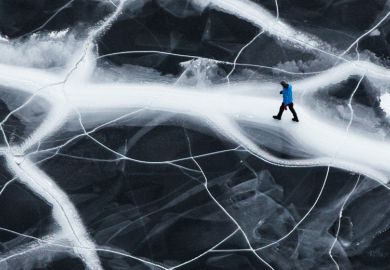At the world’s northernmost university, staff and students are preparing for the Arctic winter: two months when the sun never rises above the horizon and the temperature rarely climbs above freezing.
For Lasse Lønnum, director of UiT The Arctic University of Norway in Tromsø, this brings practical concerns: offering support to students who may struggle to adjust to the harsh environment, and switching on the specialist lighting that substitutes for sunlight in accommodation blocks.
“We spend a lot of money on electricity,” he quipped.
This isn’t the only adaptation that the university has to make to its environment, with its main campus sitting 190 miles inside the Arctic Circle. Every summer, there are two months of continuous sunlight, and blackout blinds are needed in dormitories to allow students to sleep.
The region’s geography is a challenge, too. The university has three further main campuses, in Alta, Narvik and Harstad, with six others spread across northern Norway – 200 miles (320km) separate the most northerly and southerly sites. It also has observatories in locations as far-flung as the Svalbard archipelago, midway between mainland Norway and the North Pole, where temperatures average between -12°C and -16°C in winter.
But remoteness also brings clean air, beautiful nature and a chance to glimpse the Northern Lights, meaning that Tromsø’s location is as much a help as it is a hindrance when it comes to attracting staff and students, Mr Lønnum argued. One in 10 of the university’s students is international – there are learners from South America and Africa – while about 80 nations are represented among the institution’s combined staff and student body.
“You get used to the all-day sun and the dark period: it’s manageable,” Mr Lønnum said. “It’s the wilderness experience, and you can experience that on all of our campuses.
“If you are a big city, comfortable student, you won’t choose us. But I think the students who haven’t been in Tromsø before say that they are surprised at how nice it is to be a student at one of our campuses.”
For Mr Lønnum, “location, location, location” is key to the identity of the university, which is Norway’s third-largest. Many of its research specialisms focus on Arctic issues, such as climate change, oceanography and marine bioprospecting, while it also has expertise in peace studies and in the study of Norway’s indigenous Sami people.
As concern about the future of the Arctic has increased, so has the significance of the university’s research. “We are in the Arctic, and that gives us a big advantage doing Arctic research,” Mr Lønnum said.
It has also been a collaborative effort: Tromsø is working with universities and research institutes across Norway on Arctic projects, and is also a founder member of an organisation called the University of the Arctic, a network of more than 170 universities and organisations from the eight Arctic countries and beyond, which work in partnership on research projects and have jointly developed a series of courses in “circumpolar studies”.
Only time will tell if these efforts are successful, but in terms of the regional economy at least, Mr Lønnum believes that the university is having a big impact. Unemployment in the region is low, and industries such as oil and gas and fish farming offer new opportunities, he argued.
“The economy is growing in this part of Norway,” Mr Lønnum said. “I think universities have a role in that, to support societies in the north with good students and relevant research.”
The university faces challenges if it is to maintain its important position in Arctic affairs. In coming years, many of the researchers who helped to launch the institution as young academics in 1972 will be retiring, and a major recruitment drive is required to replenish the ranks.
And despite the university’s size and its research output – which also covers the social sciences and humanities – Mr Lønnum concedes that Tromsø’s remoteness means that policymakers “often forget” the institution. Making sure that the university’s voice is heard is a key part of Mr Lønnum’s role.
“We have to constantly remind decision-makers in Oslo that we are here and we are in the north,” he said. “We have to promote our expertise and our competence.”
POSTSCRIPT:
Print headline: A northern star that shines light on Arctic issues and opportunities
Register to continue
Why register?
- Registration is free and only takes a moment
- Once registered, you can read 3 articles a month
- Sign up for our newsletter
Subscribe
Or subscribe for unlimited access to:
- Unlimited access to news, views, insights & reviews
- Digital editions
- Digital access to THE’s university and college rankings analysis
Already registered or a current subscriber?








